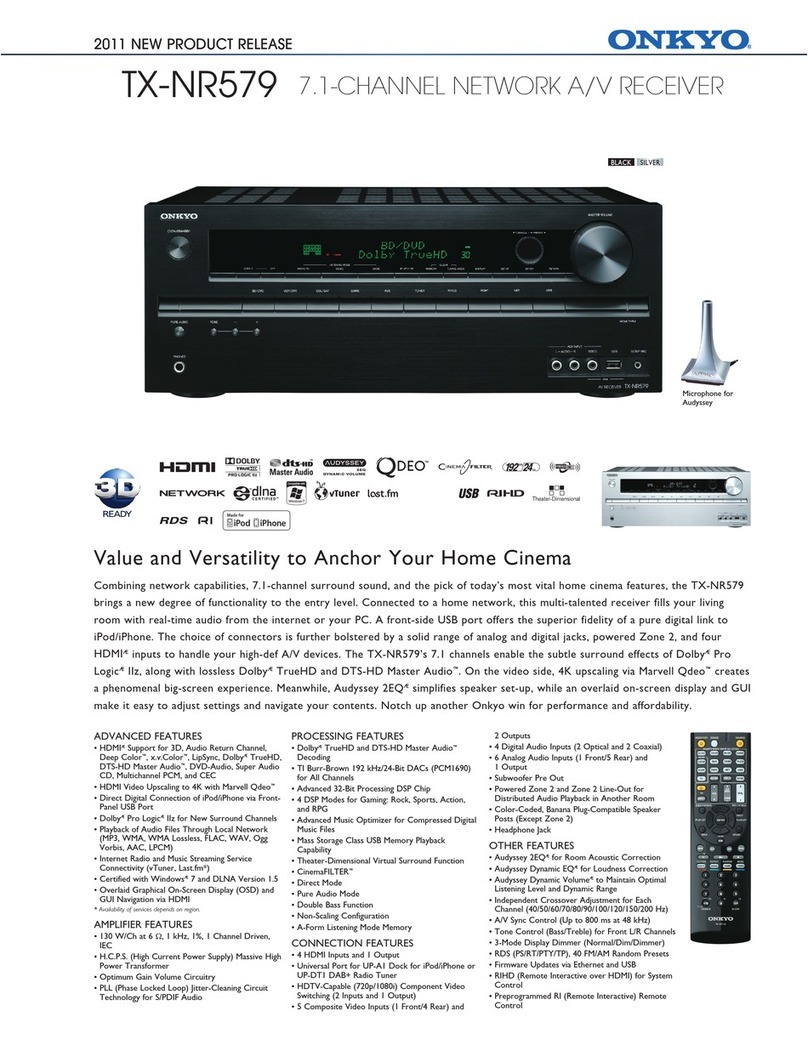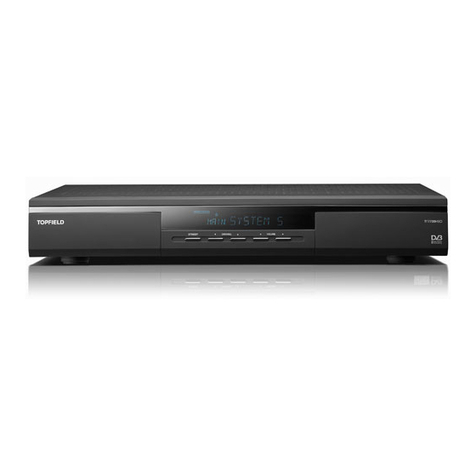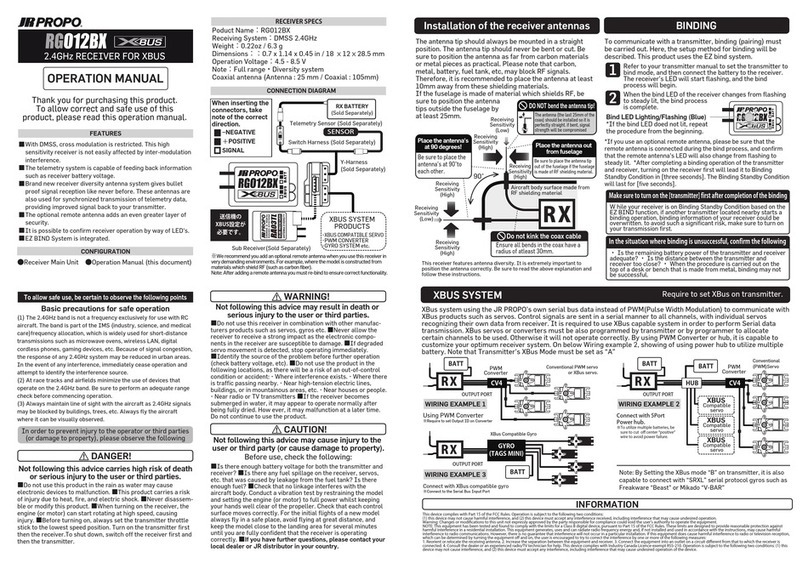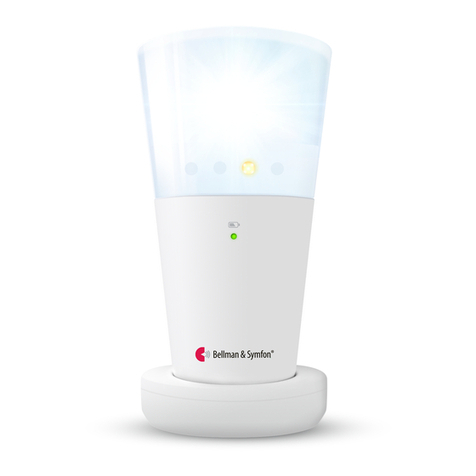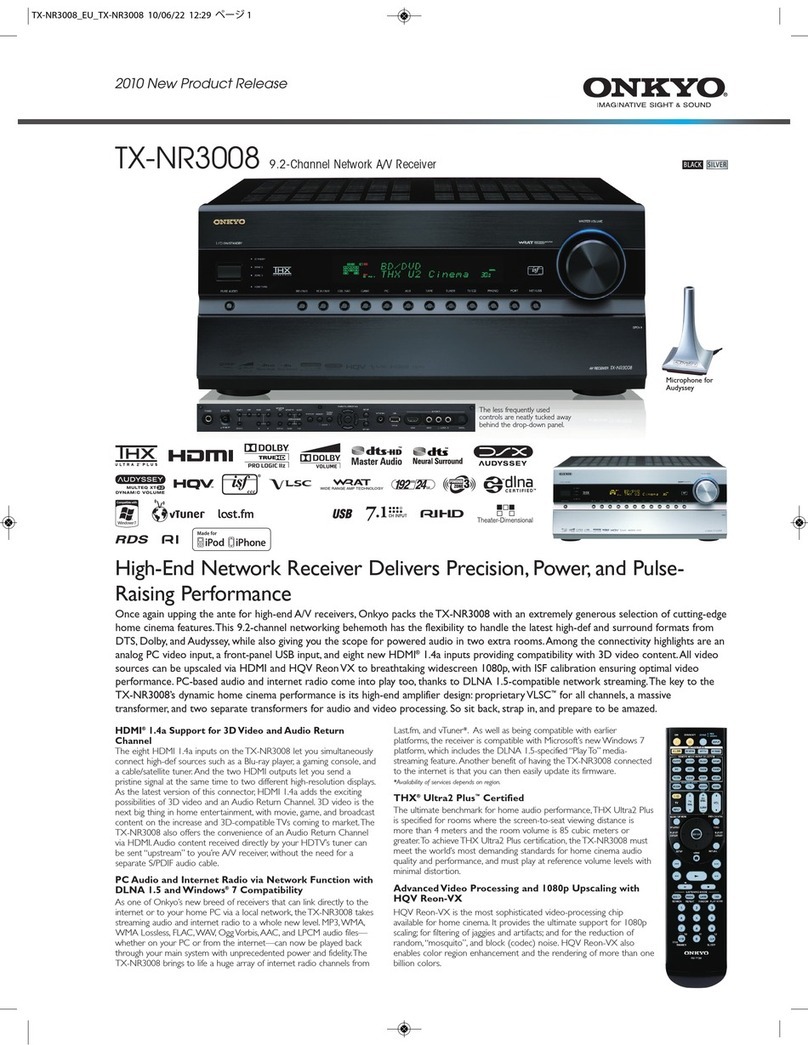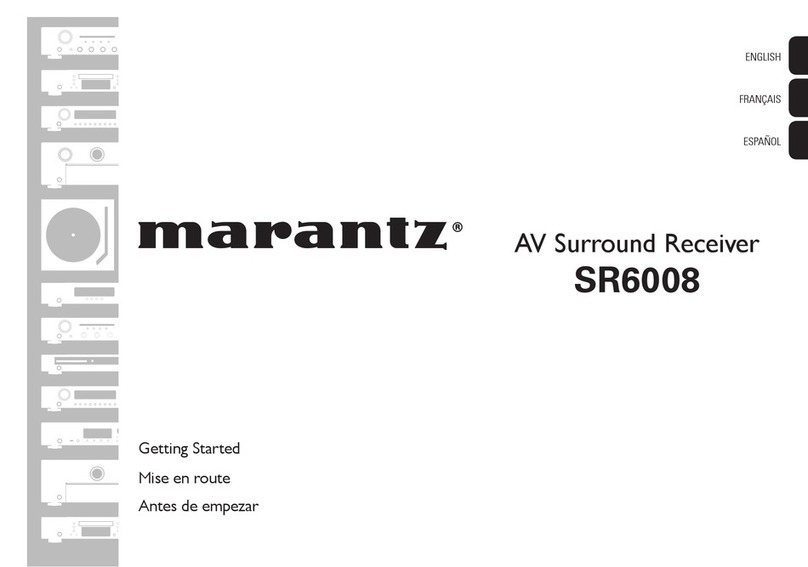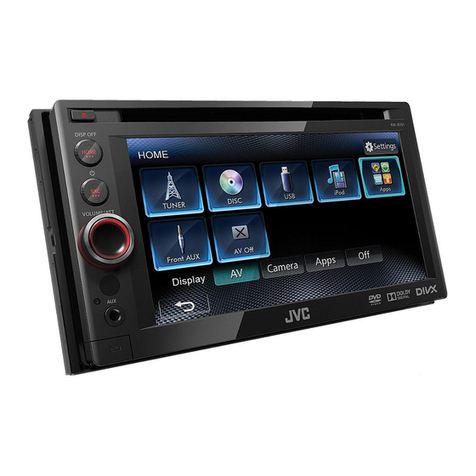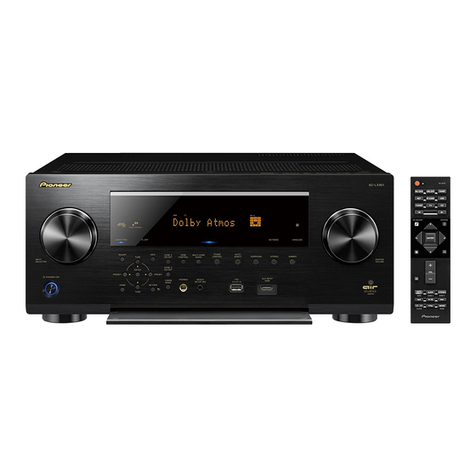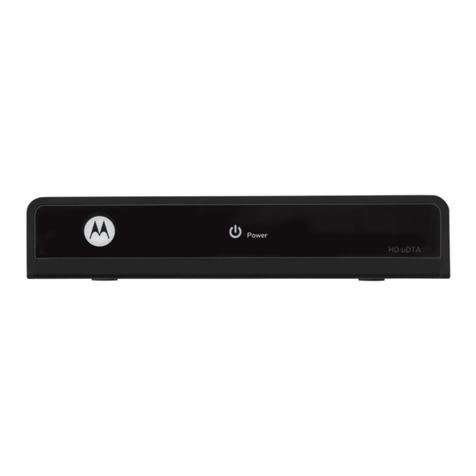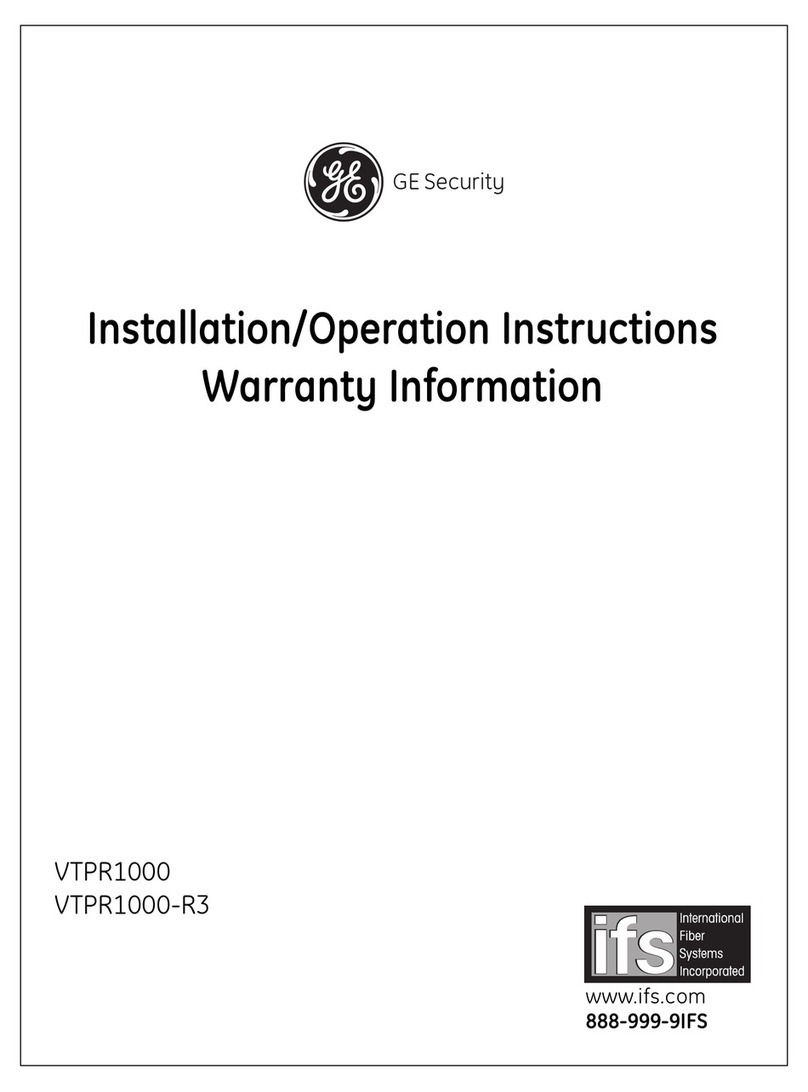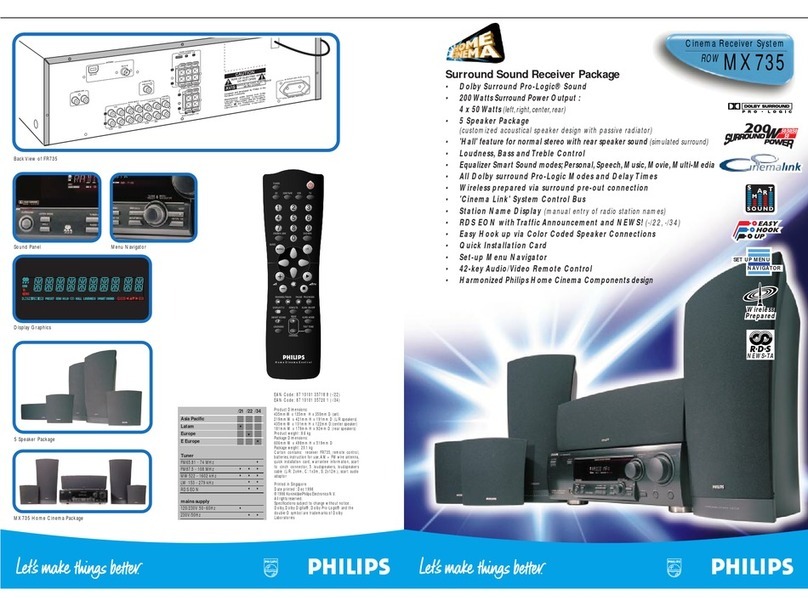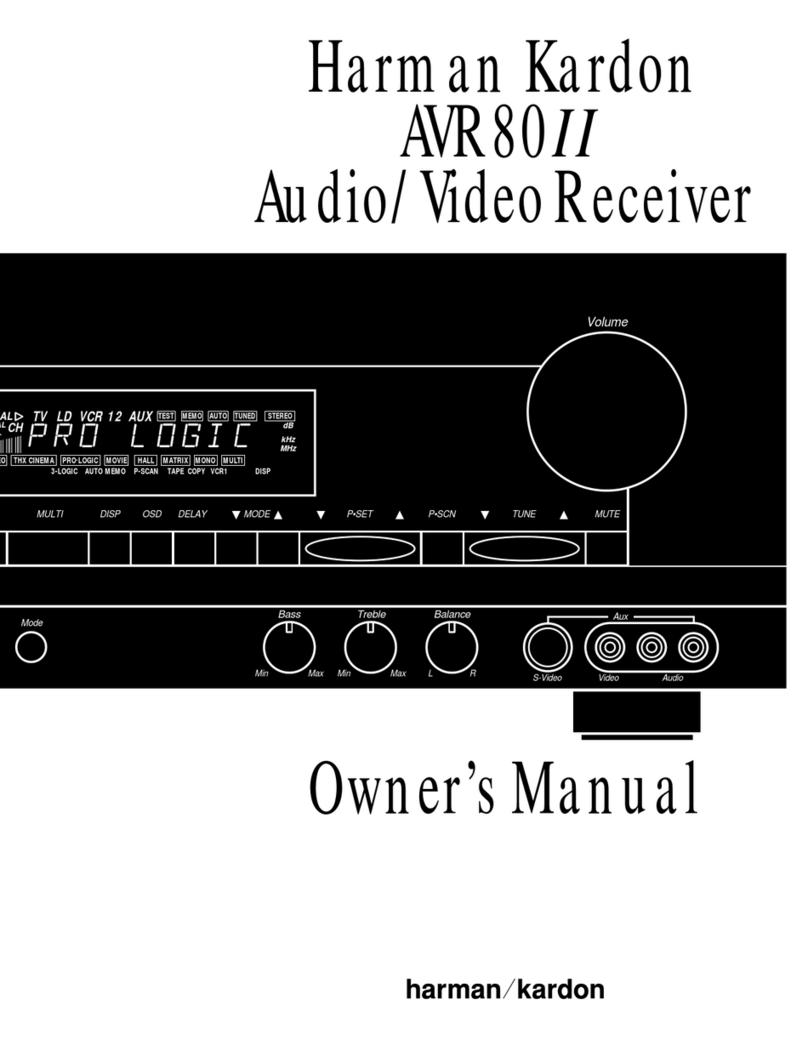Omnitronic DAD-4RXH User manual


2
•
DE
Inhalt
1 Einführung .................................. 2
1.1 Produktmerkmale ......................... 2
1.2 Lieferumfang ................................ 2
2 Sicherheitshinweise .................. 3
3 Bedienelemente und
Anschlüsse ................................. 4
4 Inbetriebnahme .......................... 5
4.1 Aufstellmöglichkeiten ................... 5
4.2 Antennen anschließen ................. 5
4.3 Einbau eines oduls .................... 5
4.4 Anschlüsse herstellen .................. 5
5 Technische aten ...................... 6
5.1 Stecker- und
Anschlussbelegungen .................. 6
D00125488,
Version 1.0, Stand 19/08/2019
Produkt-Updates, Dokumentationen, Software und
Support erhalten Sie unter www.omnitronic.de. Die
neueste Version der Bedienungsanleitung finden Sie im
Downloadbereich des Produkts.
© 2019 O NITRONIC. Alle Rechte vorbehalten.
Dieses Dokument darf ohne schriftliche Genehmigung
des Copyrightinhabers weder ganz noch teilweise
reproduziert werden. Der Inhalt dieses Dokuments kann
ohne vorherige Ankündigung modifiziert werden, wenn
Änderungen in ethodik, Design oder Herstellung dies
erforderlich machen.
Alle in diesem Dokument erwähnten arken gehören
den jeweiligen Eigentümern.
1 Einführung
Willkommen bei Omnitronic! Schön, dass Sie sich
für eines unserer Produkte entschieden haben.
Diese Bedienungsanleitung zeigt Ihnen, wie Sie
das Gerät in Betrieb nehmen und nutzen. Damit
Sie sich und andere keinen Gefahren aussetzen,
beachten Sie bitte unbedingt alle Sicherheits-
hinweise in dieser Anleitung und alle auf dem
Gerät angebrachten Sicherheitshinweise.
Diese Bedienungsanleitung gilt für die
Artikelnummer: 13106940. Bitte bewahren Sie
dieses Dokument für weiteren Gebrauch auf und
geben Sie es ggf. an nachfolgende Besitzer
weiter.
1.1 Produktmerkmale
• 4 Einschübe zum Einbau von Empfangs- und
Sendemodulen der O - und DAD-Serie
• Unterstützt die Funkmikrofone und
Taschensender der O - und DAD-Serie
• Unterstützt das W T/R-2 Funksystem
• Betrieb in den anmeldefreien Frequenzbereichen
823-832 Hz und 863-865 Hz
• Sym. XLR-Ausgang pro Kanal
• Unsym. 6,3-mm-Klinkenausgang für ischsignal
• 2 Antennenanschlüsse (BNC)
• 2 AUX-Eingänge (3,5-mm-Klinke) für Kanal 3
und 4
• Non-Diversity-System
• Robustes etallgehäuse
• 483-mm-Rackeinbau
• Inkl. Steckernetzteil 12V/1A
1.2 Lieferumfang
• DAD-4RXH Empfängergehäuse
• 2 BNC-Antennen
• 1 eter Audiokabel (6,3-mm-Klinke)
• Steckernetzteil
• diese Bedienungsanleitung

3
•
DE
2 Sicherheitshinweise
• Bitte lesen Sie vor der Verwendung des Produkts diese Anleitung. Sie enthält wichtige
Hinweise für den korrekten Betrieb. Bewahren Sie diese Anleitung für weiteren Gebrauch auf.
• Das Gerät ist speziell zur Aufnahme von vier Funkmodulen der O - und DAD-Serie von
Omnitronic konzipiert. it den odulen lassen sich Audio-Übertragungsstrecken in den UHF-
Frequenzbändern 823-832 und 863-865 Hz aufbauen. In alle Einschübe können
Empfangsmodule eingebaut werden. Die Einschübe 3 und 4 können auch für Sendemodule
genutzt werden. Jeder Einschub bietet einen XLR-Direktausgang. Zusätzlich sind ein
Summenausgang (6,3-mm-Klinke) und zwei AUX-Eingänge (3,5-mm-Klinke) für die Einschübe
3 und 4 vorhanden.
• Das Gerät ist zum Betrieb in der EU vorgesehen. Der Frequenzbereich 863-865 Hz ist in der
EU allgemein zugeteilt und anmelde- und gebührenfrei. Der Frequenzbereich 823-832 Hz ist
in Deutschland anmelde- und gebührenfrei unterliegt aber in einigen EU-Ländern
Beschränkungen: AT, LV. LT, PL, SE, GB (Stand 2018). Stellen Sie vor dem Betrieb sicher,
dass die gewünschten Frequenzen in Ihrem Land zugelassen sind. Weiterführende
Informationen erhalten Sie bei Ihrer nationalen Behörde.
• Verwenden Sie das Produkt ausschließlich gemäß den hier gegebenen Vorgaben, damit es
nicht versehentlich zu Verletzungen oder Schäden kommt.
• Bei Sach- oder Personenschäden, die durch unsachgemäße Handhabung oder Nichtbeachten
dieser Bedienungsanleitung verursacht werden, übernehmen wir keine Haftung und es erlischt
jeder Garantieanspruch.
• Aus Sicherheitsgründen ist das eigenmächtige Umbauen oder Verändern des Produkts ist nicht
gestattet und hat den Verfall der Garantieleistung zur Folge.
• Um die Gefahr eines elektrischen Schlages zu vermeiden, niemals irgendeinen Teil des
Produkts öffnen. Nur an eine vorschriftsmäßige Steckdose anschließen, die der
Produktspezifikation entspricht. Verlegen Sie das Anschlusskabel so, dass es nicht zur
Stolperfalle wird.
• Das Produkt ist für den trockenen Innenbereich ausgelegt. Schützen Sie es vor extremen
Temperaturen, direktem Sonnenlicht, starken Erschütterungen, hoher Feuchtigkeit, Nässe,
brennbaren Gasen, Dämpfen und Lösungsmitteln. Der ideale Temperaturbereich liegt bei -5 bis
+45 °C.
• Niemals das Netzkabel und den -stecker mit nassen Händen berühren, da die Gefahr eines
Stromschlags besteht.
• Die Reinigung beschränkt sich auf die Oberfläche. Dabei darf keine Feuchtigkeit in
Anschlussräume oder an Netzspannung führende Teile gelangen. Wischen Sie das Produkt nur
mit einem trockenen, fusselfreien Tuch ab. Zuvor den Netzstecker aus der Steckdose ziehen.
• Wenn das Produkt nicht mehr ordnungsgemäß funktioniert oder Schäden aufweist, nehmen Sie
es bitte außer Betrieb und kontaktieren Ihren Fachhändler. Niemals selbst Reparaturen
durchführen.
• Gehen Sie vorsichtig mit dem Produkt um. Durch Stöße, Schläge oder dem Fall aus bereits
geringer Höhe wird es beschädigt.
• Das Produkt ist kein Spielzeug. Halten Sie es vor Kindern und Haustieren fern. Lassen Sie
Verpackungsmaterial nicht achtlos liegen.
Informationen zur Entsorgung
Bitte übergeben Sie das Gerät bzw. die Geräte am Ende der Nutzungsdauer zur
umweltgerechten Entsorgung einem örtlichen Recyclingbetrieb. Geräte, die mit diesem Symbol
gekennzeichnet sind, dürfen nicht im Hausmüll entsorgt werden.
Für weitere Informationen
wenden Sie sich bitte an Ihren Händler oder die zuständige örtliche Behörde. Entnehmen Sie evtl.
eingelegte Batterien und entsorgen Sie diese getrennt vom Produkt.
Als Endverbraucher sind Sie durch die Batterieverordnung gesetzlich zur Rückgabe aller
gebrauchten Batterien und Akkus verpflichtet. Die Entsorgung über den Hausmüll ist verboten.
Verbrauchte Batterien können Sie unentgeltlich bei den Sammelstellen Ihrer Gemeinde und
überall, wo Batterien verkauft werden, abgeben. it der Verwertung von Altgeräten und der
ordnungsgemäßen Entsorgung von Batterien und Akkus leisten Sie einen wichtigen Beitrag zum
Schutz unserer Umwelt.

4
•
DE
3 Bedienelemente und Anschlüsse
Nr. Element Funktion
1 Einschubschacht 1 Zur Installation eines Empfangsmoduls.
2 Einschubschacht 2 Zur Installation eines Empfangsmoduls.
3 Einschubschacht 3 Zur Installation eines Empfangs- oder Sendemoduls.
4 Einschubschacht 4 Zur Installation eines Empfangs- oder Sendemoduls.
5 Netzschalter Zum Ein-/Ausschalten des Geräts.
6 Antennenanschluss Gemeinsame BNC-Buchse für Einschub 1 und 2.
7 Antennenanschluss Gemeinsame BNC-Buchse für Einschub 3 und 4.
8 AUX-Anschluss Zum Einspeisen eines Audiosignals in ein Sendemodul in Einschub 4.
9 AUX-Anschluss Zum Einspeisen eines Audiosignals in ein Sendemodul in Einschub 3.
10 Ausgang IX OUT Summenausgang (Klinke) aller Empfangsmodule.
11 Ausgang Einschub 4 XLR-Ausgang des Empfangsmoduls in Einschub 4.
12 Ausgang Einschub 3 XLR-Ausgang des Empfangsmoduls in Einschub 3.
13 Ausgang Einschub 2 XLR-Ausgang des Empfangsmoduls in Einschub 2.
14 Ausgang Einschub 1 XLR-Ausgang des Empfangsmoduls in Einschub 1.
15 Netzanschluss Stecken Sie hier die Anschlussleitung des beiliegenden Netzteils ein.
1
2
3
4
5
7
6
8
9
11
12
13
14
15
10

5
•
DE
4 Inbetriebnahme
4.1 Aufstellmöglichkeiten
Das Gerät ist als Tischgerät oder für den Einschub in ein 19“-Rack (483 mm) vorgesehen. Das Gerät kann
mit vier Schrauben 6 im Rack befestigt werden und benötigt 1 Höheneinheit.
Hinweise
• Achten Sie bei der Standortwahl des Geräts immer auf eine ausreichende Luftzufuhr, um eine Überhitzung
des Geräts zu vermeiden. Dauerhafte Überhitzung kann zu Schäden am Gerät führen.
• Halten Sie mindestens 1 eter Abstand zum Boden und zu angrenzenden Wänden ein.
• Vermeiden Sie Störquellen wie etallflächen oder elektronische Geräte (z. B. Computer, CD-Player).
4.2 Antennen anschließen
Schließen Sie die beiden beiliegenden Antennen an die Buchsen „ANT 1-2“ und „ANT 3-4“ an. Richten Sie
die Antennen V-förmig nach oben aus.
Hinweise
• Idealerweise sollten sich die Empfangsantennen in Höhe des Senders befinden. Beim Einsatz mehrerer
Systeme dürfen sich die Antennen nicht überkreuzen oder berühren.
• Für optimalen Empfang sollte zwischen Sender und Empfänger Sichtverbindung bestehen und sie sollten
sich in einem indestabstand von 1 eter zueinander befinden.
4.3 Einbau eines Moduls
Vor dem Einbau eines oduls den Netzstecker des DAD-4RX aus der Steckdose ziehen.
1) Schrauben Sie die Abdeckblende des entsprechenden Einschubschachts ab.
2) Schieben Sie das odul vorsichtig in den Schacht bis es an die Kontaktleiste stößt. Rasten Sie das
odul mit einem leichten Druck ein.
3) Schrauben Sie das odul fest.
4) Weitere Installationsschritte und Details zur Bedienung entnehmen Sie bitte der Bedienungsanleitung
des verwendeten Drahtlossystems.
4.4 Anschlüsse herstellen
Um Störgeräusche zu vermeiden, sollte das Gerät vor dem Herstellen und Trennen von Verbindungen
ausgeschaltet sein.
1) Schließen Sie die XLR-Direktausgänge „CH 1-4 OUT“ der Empfangskanäle an je einen symmetrischen
ikrofoneingang des nachfolgenden Geräts (z. B. ischpult) an. Stellen Sie mit den Lautstärkereglern
der Empfangsmodule die gewünschte Lautstärke ein.
2) An der unsymmetrisch beschalteten 6,3-mm-Klinkenbuchse „ IX OUT“ liegt das Summensignal aller
Empfangsmodule an. Verwenden Sie diese Buchse zum Anschluss an einen ikrofoneingang oder
hochempfindlichen Line-Eingang. Stellen Sie mit den Lautstärkereglern der Empfangsmodule die
gewünschte Lautstärke und das ischungsverhältnis ein.
3) Die AUX-Anschlüsse „AUDIO IN“ können zum Einspeisen von Audiosignalen (max. 1 V) in die
Sendemodule genutzt werden. Stellen Sie mit den Lautstärkereglern der Sendemodule den
gewünschten Lautstärkepegel ein.
4) Verbinden Sie zum Schluss die Anschlussleitung des Netzteils mit der Netzanschlussbuchse am
DAD-4RX und stecken Sie das Netzteil in die Steckdose ein. Betreiben Sie das Gerät immer nur mit
diesem passenden Netzteil. Trennen Sie immer die Verbindung zum Netz, wenn Sie die Leitungen
umstecken, das Gerät an einen anderen Platz stellen wollen oder bei längeren Betriebspausen.

6
•
DE
5 Technische Daten
A -4RXH
System: Non-Diversity, 4 Kanäle
Frequenzband: 823-832 Hz und 863-865 Hz
Spannungsversorgung: 12-18 V DC, 1 A über mitgeliefertes Netzteil an 100-240 V AC, 50/60 Hz
Gesamtanschlusswert: 12 W
Anschlüsse: ic: XLR, sym.
ix: 6,3-mm-Klinke, unsym.
Aux: 3,5-mm-Klinke
aße (LxBxH): 481 x 245 x 45 mm
Gewicht: 2,1 kg
Technische Daten können im Zuge der Weiterentwicklung des Produkts ohne vorherige Ankündigung geändert werden.
5.1 Stecker- und Anschlussbelegungen
Für eine gute Klangqualität sollten Sie hochwertige, möglichst kurze Kabel verwenden. Nachfolgend finden
Belegungsbeispiele für die jeweiligen Anschlüsse.
Steckverbindung Aufbau Symmetrischer
Anschluss
Unsymmetrischer
Anschluss
XLR, männl.
Rot = 2
Schwarz = 3
Schirm = 1
Rot = 2
Schirm = 1 + 3
6,3-mm-Klinke, stereo
Rot = Spitze
Schwarz = Ring
Schirm = Schaft
Rot = Spitze
Schirm = Schaft +
Ring
6,3-mm-Klinke, mono
Rot = Spitze
Schwarz = Ring
Schirm = unverb.
Rot = Spitze
Schirm = Schaft
3,5-mm-Klinke, stereo
Rot = Spitze
Schwarz = Schaft
Schirm = unverb.
Rot = Spitze
Schirm = Schaft
2
3
1
3
1
2
3
1
2
Spitze
Schirm Schirm
Ring
Spitze
Schirm
Spitze
Schirm
Ring Ring
Spitze
Schirm
Spitze
Schirm
Spitze
Ring
Stecker Kabel

7
•
EN
Contents
1
Introduction ................................ 7
1.1
Product features ........................... 7
1.2
Package contents ........................ 7
2
Safety Instructions ..................... 8
3
Operating Elements and
Connections ............................... 9
4
Setup and Operation ................ 10
4.1 Setup .......................................... 10
4.2 Antenna connections ................. 10
4.3 Installing a module ..................... 10
4.4 Audio connections ...................... 10
5
Technical Specifications ......... 11
5.1 Cable connections ..................... 11
D00125488,
version 1.0, publ. 19/08/2019
For product updates, documentation, software
and support please visit www.omnitronic.de.
You can find the latest version of this user
manual in the product’s download section.
© 2019 O NITRONIC. All rights reserved.
No part of this document may be reproduced in
any form without the written permission of the
copyright owner. The contents of this document
are subject to revision without notice due to
continued progress in methodology, design,
and manufacturing.
All trademarks mentioned herein are the
property of their respective owners.
1 Introduction
Welcome to Omnitronic! Thank you for choosing one of our
products.
This user manual will show you how to install and operate
the wireless microphone system. Users of this product are
recommended to carefully read all warnings in this manual
and on the unit in order to protect yourself and others from
damage.
This user manual is valid for item number: 13106940.
Please save this document for future needs and pass it on
to further owners.
1.1 Product features
• 4 inserts for receiver and transmitter modules of the O
and DAD series
• Works with O and DAD wireless microphones and
bodypacks
• Supports the W T/R-2 wireless system
• Operation in the license-free frequency ranges 823-
832 Hz and 863-865 Hz
• Balanced XLR output per channel
• Unbalanced 6.3 mm jack for mixed signal output
• 2 antenna inputs (BNC)
• 2 AUX inputs (3.5 mm jack) for channel 3 and 4
• Non-diversity system
• Durable metal housing
• 483 mm rack installation
• Incl. power adapter 12V/1A
1.2 Package contents
• DAD-4RXH receiver housing
• 2 BNC antennas
• 1m audio cable (6.3mm jack)
• Power adapter
• These instructions

8
•
EN
2 Safety Instructions
• Please read these operating instructions carefully before using the product. They contain
important information for the correct use of your product. Please keep them for future reference.
• The unit has been especially designed to accept four wireless modules of the O and DAD
series by Omnitronic. The insertion modules can be used for wireless audio transmission in the
UHF ranges 823-832 and 863-865 Hz. All insertion slots are designed for receiver modules.
Slot 3 and 4 may also be used for transmitter modules. Each slot offers a direct XLR output. In
addition, a mixed signal output (6.3 mm jack) and two AUX inputs (3.5 mm jack) are available
for slots 3 and 4.
• This product is intended for use in the EU. The operation in the 863-865 Hz frequency range
is generally approved and license-free in all EU member countries. The operation in the 823-
832 Hz frequency range is license-free in Germany, however, is subject to restrictions in
certain areas: AT, LV. LT, PL, SE, GB (status as of 2018). Prior to use, make sure that the
desired frequencies are approved and legal in your country. Consult your national authority for
possible requirements.
• Only use the product according to the instructions given herein, to avoid accidental injury or
damage.
• We do not assume any liability for material and personal damage caused by improper use or
non-compliance with these operating instructions. In such cases, the warranty/guarantee will be
null and void.
• Unauthorized rebuilds or modifications of the product are not permitted for reasons of safety
and render the warranty invalid.
• To reduce the risk of electric shock, do not open any part of the product. Only connect the
product to a proper wall socket that complies with the product specification voltage. Run the
mains cable in such a way that it cannot be tripped over.
• This product is intended for indoor use only. Protect it from extreme temperatures, direct
sunlight, strong jolts, high humidity, moisture, flammable gases, vapors and solvents. The
recommended temperature range is -5 to +45 °C.
• Do not touch the power cord and connectors with wet hands as it may cause electric shock.
• Cleaning of the product is limited to the surface. ake sure that moisture does not come into
contact with any areas of the terminal connections or mains voltage control parts. Only wipe off
the product with a dry, lint-free cloth. Before cleaning, disconnect the product from the mains.
• If this product is no longer working properly or is visibly damaged, take it out of operation and
consult your local dealer. Do not attempt to repair the product yourself.
• Handle the product with care; it can be damaged by impacts, blows, or accidental falls, even
from a low height.
• This product is not a toy. Keep it out of the reach of children and pets. Do not leave packaging
material lying around carelessly.
isposal of old equipment
When to be definitively put out of operation, take the product to a local recycling plant for a
disposal which is not harmful to the environment. Devices marked with this symbol must not be
disposed of as household waste. Contact your retailer or local authorities for more information.
Remove any inserted batteries and dispose of them separately from the product.
You as the end user are required by law (Battery Ordinance) to return all used
batteries/rechargeable batteries. Disposing of them in the household waste is prohibited. You
may return your used batteries free of charge to collection points in your municipality and
anywhere where batteries/ rechargeable batteries are sold. By disposing of used devices and
batteries correctly, you contribute to the protection of the environment.

9
•
EN
3 O erating Elements and Connections
No. Element Function
1 Insertion slot 1 Accepts a receiver module.
2 Insertion slot 2 Accepts a receiver module.
3 Insertion slot 3 Accepts a receiver or transmitter module.
4 Insertion slot 4 Accepts a receiver or transmitter module.
5 Power switch Switches the unit receiver on and off.
6 Antenna jack Common BNC jack for slot 1 and 2.
7 Antenna jack Common BNC jack for slot 3 and 4.
8 AUX input To feed an audio signal to a transmitter module in slot 4.
9 AUX input To feed an audio signal to a transmitter module in slot 3.
10 IX OUT jack ixed output of all receiver modules.
11 Output slot 4 XLR output of the receiver module in slot 4.
12 Output slot 3 XLR output of the receiver module in slot 3.
13 Output slot 2 XLR output of the receiver module in slot 2.
14 Output slot 1 XLR output of the receiver module in slot 1.
15 Power input Plug in the connection cable of the supplied power adapter here.
1
2
3
4
5
7
6
8
9
11
12
13
14
15
10

10
•
EN
4 Setu and O eration
4.1 Setup
The unit is designed for use as a table top unit or for insertion into a 19“ rack (483 mm). The unit can be fixed
with four 6 screws in the rack and requires 1 rack space.
Notes
• In order to ensure sufficient cooling of the unit, air must always be able to flow freely through all air vents.
• Place the receiver at least 1 meter above the ground and not too close to lateral walls.
• Avoid sources of interference such as metal surfaces or electronic devices (e.g. computer, CD player).
4.2 Antenna connections
Connect the two antennas supplied with the system to the jacks “ANT 1-2“ and “ANT 3-4”. Put the antennas
upright in a V-shaped position.
Notes
• Ideally, position the receiving antennas at the height of the transmitter. When using multiple systems, do
not allow antennas to cross or touch each other.
• For optimum reception, keep the transmitter at least 1 meter away from the receiver and avoid obstacles.
4.3 Installing a module
Prior to installing a module, disconnect the mains plug of the DAD-4RX from the mains socket.
1) Screw off the cover panel of the corresponding insertion slot.
2) Carefully insert the module into the slot until it touches the contact strip. Lock the module in place
exerting a slight pressure.
3) Tighten the module with screws.
4) For all further installation steps and details of operation refer to the operating instructions of the wireless
system.
4.4 Audio connections
To avoid interfering noise, switch off the unit prior to connecting and disconnecting equipment.
1) Connect the direct XLR outputs “CH 1-4 OUT” of the receiver channels to a balanced microphone input
each of a subsequent unit (e.g. mixer). Use the volume controls of the receiver modules to adjust the
desired volume.
2) The master signal of all receiver channels is provided at the unbalanced 6.3 mm jack “ IX OUT”. Use
this output for connection to a microphone input or a highly sensitive line input. Use the volume controls
of the receiver modules to adjust the desired volume and the mixing ratio.
3) Use the AUX inputs “AUDIO IN“ to feed audio signals (max. 1 V) to the transmitter modules. Use the
volume controls of the transmitter modules to adjust the desired volume level.
4) Finally, connect the power adapter to the power input of the DAD-4RX and the mains plug to a mains
socket. Use the DAD-4RX only with the supplied power adapter. Always disconnect the mains connector
when you wish to change connections, move the unit to a different place or if it is not used for a longer
period.

11
•
EN
5 Technical S ecifications
A -4RXH
System: Non-diversity, 4 channels
Frequency band: 823-832 Hz and 863-865 Hz
Power supply: 12-18 V DC, 1 A via supplied power unit connected to 100-240 V AC,
50/60 Hz
Power consumption: 12 W
Connections: ic: XLR, bal.
ix: 6.3 mm jack, unbal.
Aux: 3.5 mm jack
Dimensions (LxWxH): 481 x 245 x 45 mm
Weight: 2.1 kg
Specifications are subject to change without notice due to product improvements.
5.1 Cable connections
Be sure to use only high-grade cables. The illustrations below show the wiring of these cables.
Connector Structure Balanced
connection
Unbalanced
connection
XLR, female
red = 2
black = 3
shield = 1
red = 2
shield = 1 + 3
6.3mm jack, stereo
red = tip
black = ring
shield = sleeve
red = tip
shield = sleeve +
ring
6.3 mm jack, mono
red = tip
black = ring
shield = n/c
red = tip
shield = sleeve
3.5mm jack, stereo
red = tip
black = ring
shield = sleeve
red = tip
shield = sleeve +
ring
2
3
1
3
1
2
3
1
2
tip
sleeve
ring tip
sleeve
ring
tip
sleeve
tip
sleeve
ring ring
tip
sleeve
tip
sleeve
plug
side cable
side

.
©
OMNITRONIC 201
9
D00125488
Version 1.0
O
mnitronic
is a brand of Steinigke
Showtechnic
GmbH
Andreas-Bauer-Str. 5
97297 aldbüttelbrunn, Germany
Table of contents
Languages:
Other Omnitronic Receiver manuals

Omnitronic
Omnitronic DR-1000 MK2 User manual
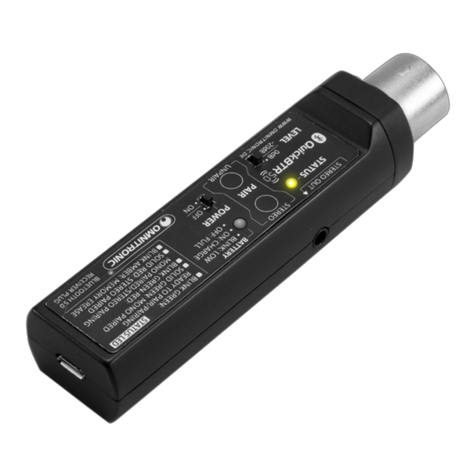
Omnitronic
Omnitronic QuickBTR-5.0 User manual
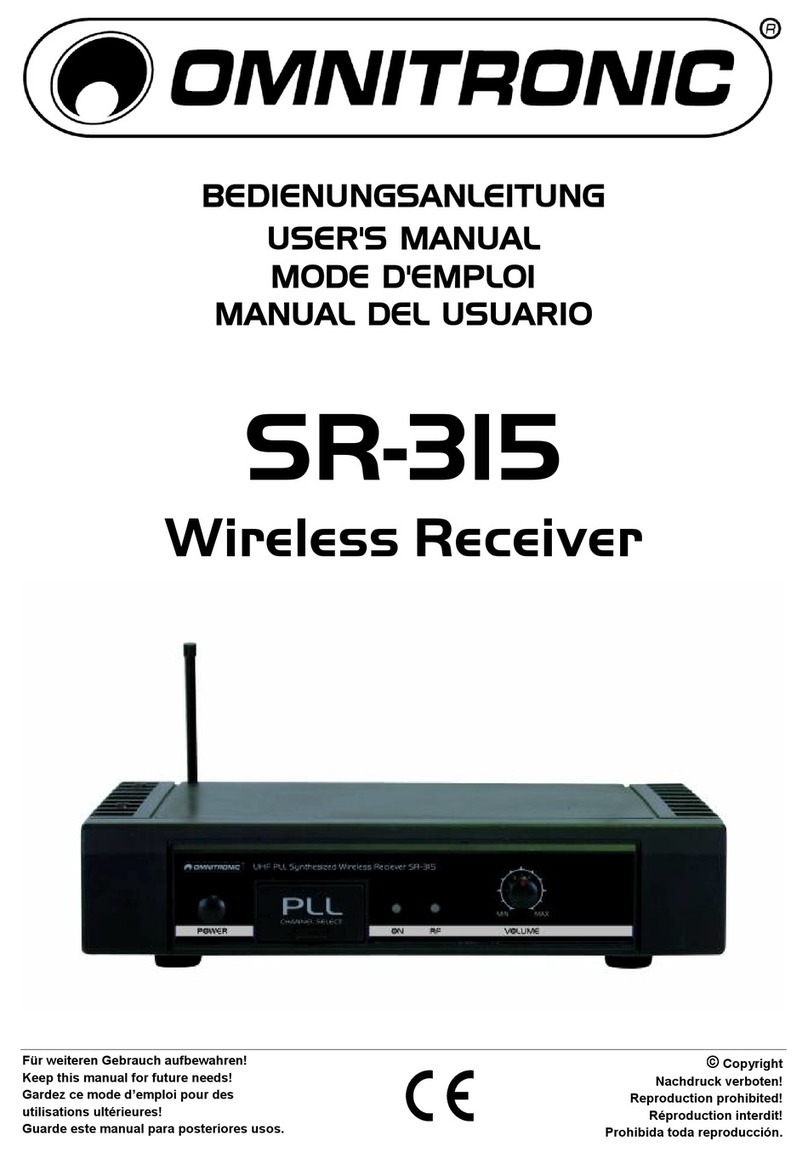
Omnitronic
Omnitronic SR-315 User manual
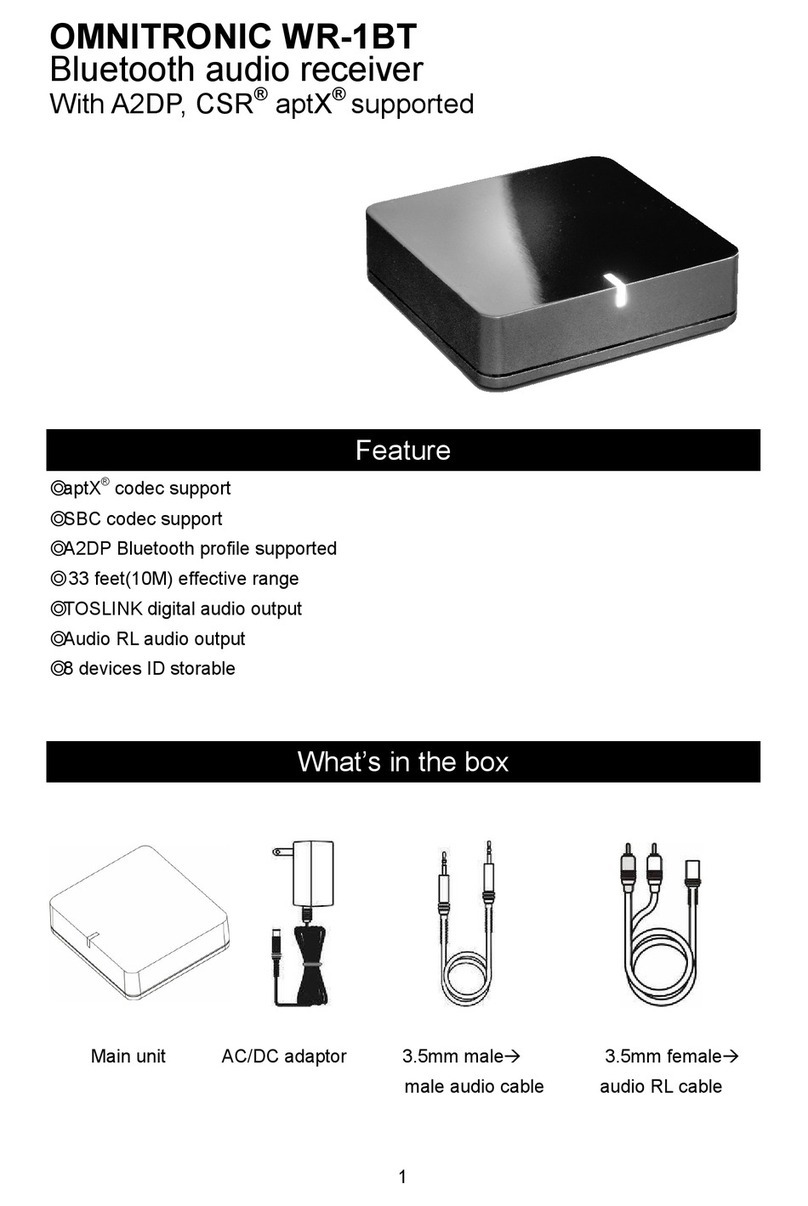
Omnitronic
Omnitronic WR-1BT User manual

Omnitronic
Omnitronic DR-415 User manual
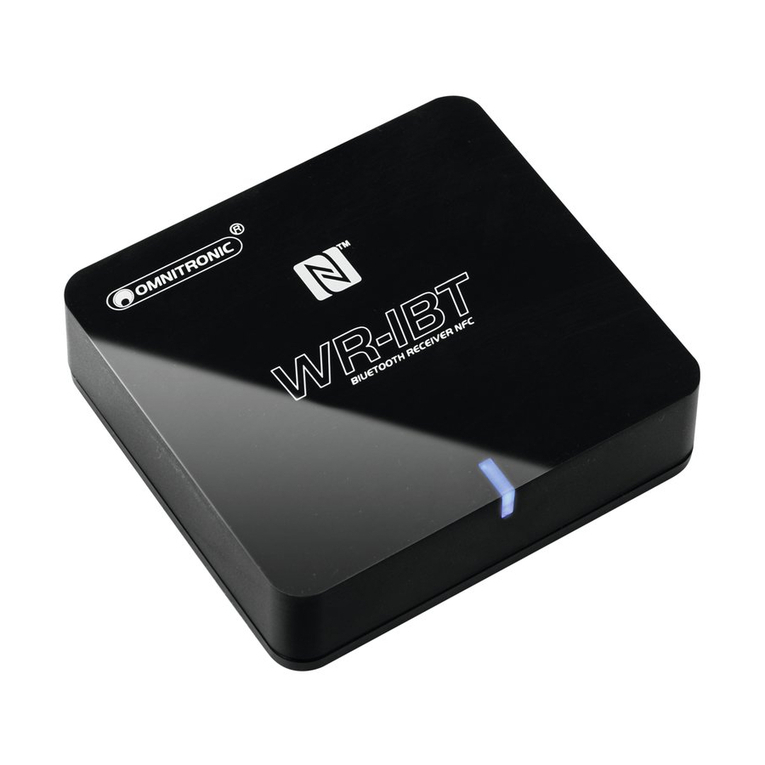
Omnitronic
Omnitronic WR-1BT User manual
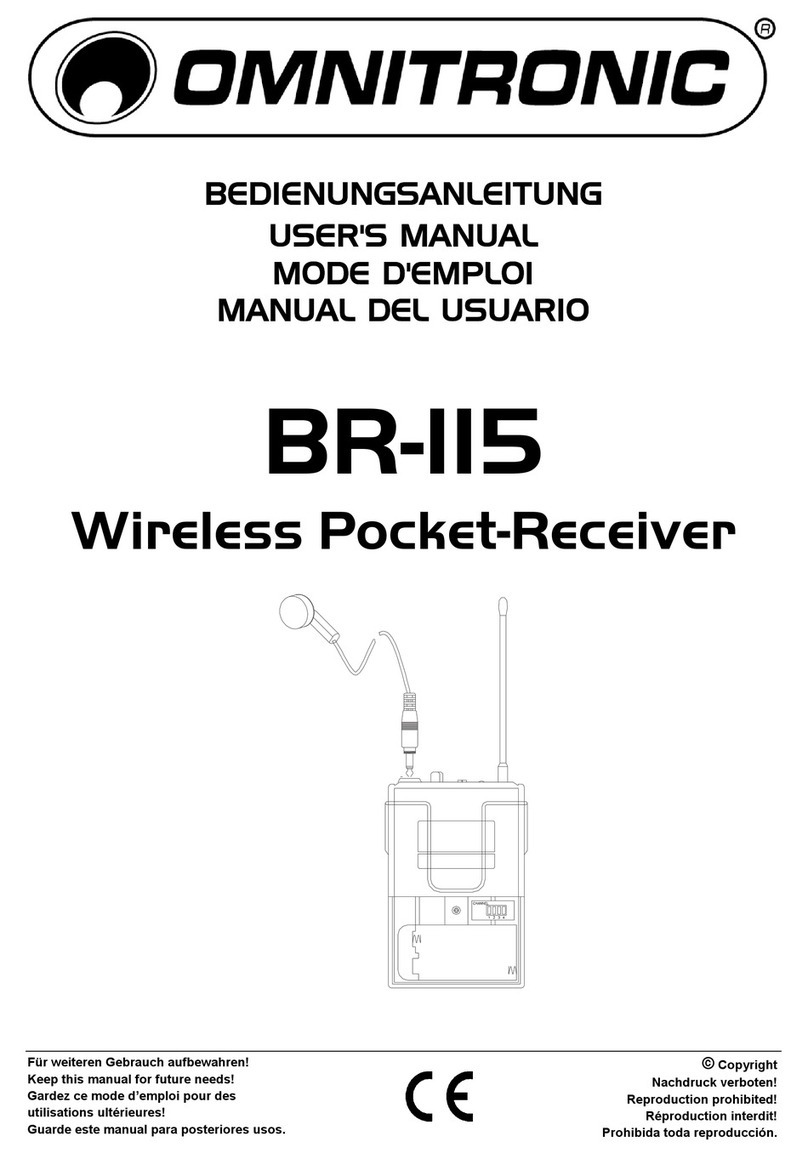
Omnitronic
Omnitronic BR-115 User manual

Omnitronic
Omnitronic STR-1000 User manual

Omnitronic
Omnitronic DR-1000 User manual
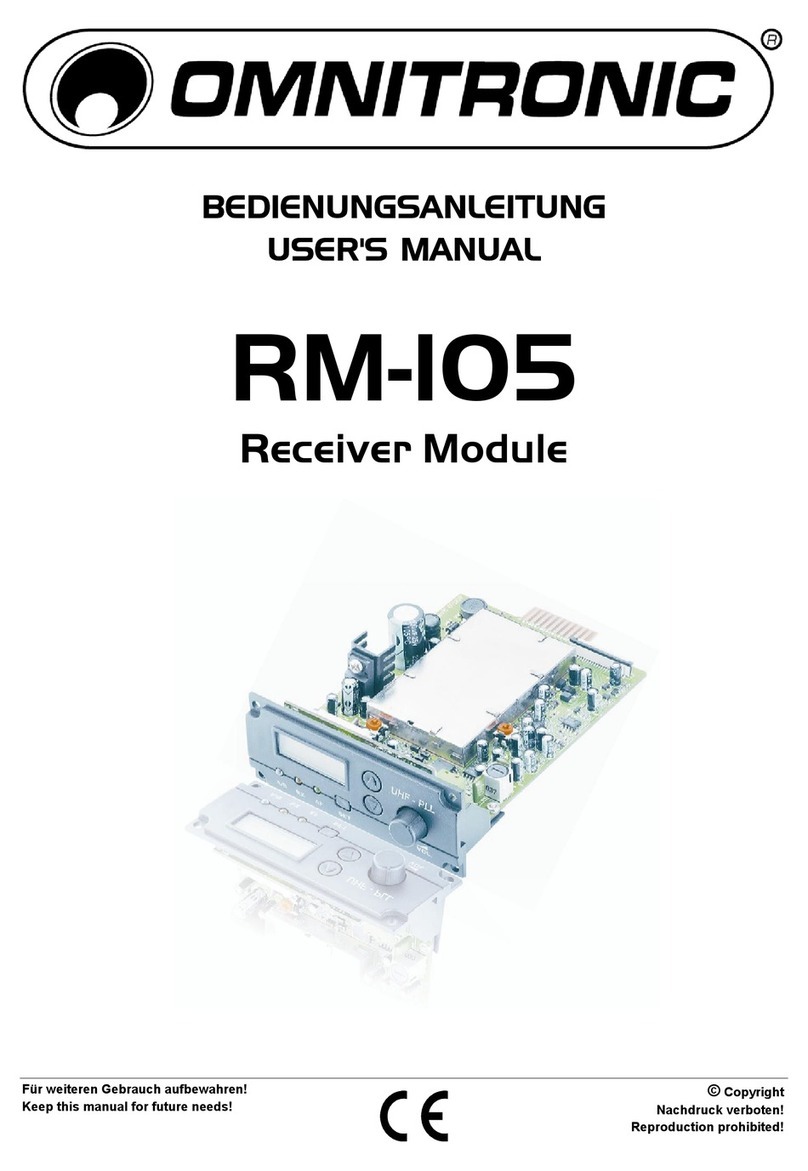
Omnitronic
Omnitronic RM-105 User manual
